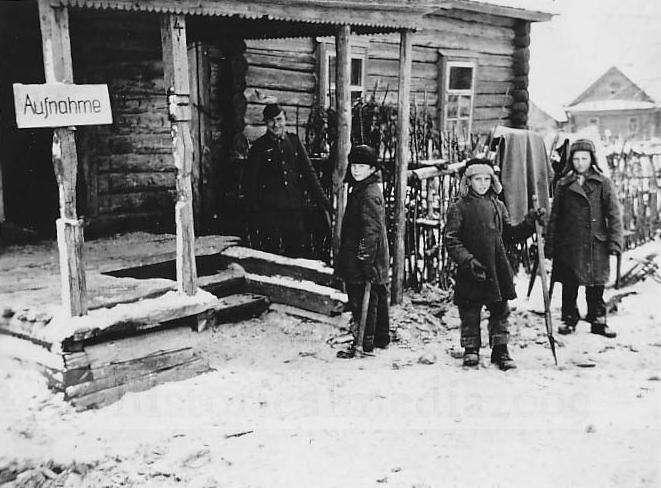
Operation Barbarossa: Civilians in Different Regions

Figure 1.--HBC sees pohotographs as little historical documents. We have found thousands of snapshots taken by the German soldiers involved with Barbarossa. These are not propaganda photogrphs, but more like tourist photographs. Many of the soldiers took photographs of the children, many of whom were attracted to ge soldiers out of interest or prospcts of earning a few coins or food. The children here hasve been shoveliong snow for the Germans. The sign reads "Aufnahme" (Admissions). We have no idea to what admissions means. The background we think suggests a small town or collective farm. The snapshot was probably taken in November 1941. Note that the German soldier is wearing a summer unifiorm. We suspect thst neither the soldiers or locals (children and parents) had any idea what the NAZIs were planning in the East for the Slavs. I think these ad other photos reflected the often friendly attitude of the average Wehrmsact soldier toward non-Jewish children. The attitude of the children is more difficult to weork out.
|
|
The Soviet civilan reaction to the German invaders depended somewhat on the regions involved. Stalin as a result of the NAZI-Soviet Non-Agression Pact (August 1939) and the resulkting alliance with Hitler had pushed the borders of the Soviet Union to the west at the eexpende of Poland, Finland, the Baltics and Romaia. Thus much of the territory seized by the Germans has only many Soviet for a little over a year. And brutal Soviet actions had deeply alientated the local poplation. In the western Ukrane, the Soviets held the territory for much longer, but were also very unpopulsar. In addition, the Germany Army had occupied the area in World War and belave relatively correctly. So large elements of the local population at first trated the Germans as liberators and were not full aware of NAZI race policies. It was here thast the lethality of the Holocaust was unleased on the Jews. This was begun by the Einsatzgruppen thst followed in the wake of the combat troops. And the Wehrmsacht in many asctions supported the killing. The Wehrmacht was less radicalized as regards its conduct toward non-Jews. From the beginning, elements oif the Wehrmsacht wanted to make common causde with the anti-Bolshevick nationalist groupings. This approach was vetoed by Hitler's expressed orders. This benign attitude can be seen with the average Wehrmacht soldier who took mumerous photogaphs of the local children, especially during Basrbaossa. Ad we see children with the soldiers without fear, apparebntly attempting to ear a few coins. Almost always they are boys, rarely girls or older teenagers. Many of these photgraohs are unidentified and undated, but were tasken and used to create photograpohic albums the soldiers wee compiling of their military careers.
Baltics
Stalin as a result of the Non-Agression Pact with Hitler has significantly expanded Soviet boundariess west. And in these new territories the NKVD and Red Army had carried out a ruthless campaign to purge the population of anti-Soviet elements, meaning not only people desiring an independent state, but whole classes of people who tended to have nationalist aspirations. This was the case in the Baltics. And this was the people Army Group North first encounteed.
Eastern Poland/Beylorussia
Civilians attitudes in eastern Poland/Beylorussia were more mixed. We are not yet sure just what occurred here. The populsatin was mixed, including Poles, Beylorussians, and Ukranians. The Poles had been brutalized by the Soviets, but they probably anticipated nothing better from the Germans. This was the area tht Army Group Center entered.
Ukraine
The Germans in the Western Ukraine were seen by msny as liberators. This wasthe area in which Army Group South entered.
Caucauses
And there were other peoples, especially in the Caucuses that were hostile to the Soviets. The Germans organized formations of Muslims. They were recruited both from POWs and from civilisans in occupied areas.
Russia
It was a different matter when the Wehrmact ebntered the Soviet Union's Russian heartland. Here the population remined staunchly loyal, not so much for Communism, but for Mother Russia. Civilians volunteered in large numbers to build anti-tank barriers and other defensive works. Here there was sometime as it took the Germans time to reach the Russian ethnic areas of the Soviet Union. And the Russians rallied to the cause before the genocidal nature of the NAZI invaders was fully understood. This would not be known until the Red Army offensve before Moscow (December 1941) would take back villages occupied by the Germans.
Romania
Finland
Most Finnish civilans evacuated the area seized by the Soviet Union After the Winter War (1939-40). So when the Finns attacked, most of the civilans in the area were Soviets. We do not have much information on how the Finns treated the Soiviet civilans. A Russian reader tells us that the Finns set up a concetration camp.
HBC

Navigate the Boys' Historical Clothing Web Site:
[Return to Main Barbaross civilian page]
[Return to Main Operation Barbarossa page]
[Return to Main German World War II page]
[Return to World War II First phase campaign page]
[Introduction]
[Activities]
[Biographies]
[Chronology]
[Clothing styles]
[Countries]
[Bibliographies]
[Contributions]
[FAQs]
[Glossaries]
[Images]
[Links]
[Registration]
[Tools]
[Boys' Clothing Home]
Created: 5:32 AM 10/2/2009
Last updated: 5:32 AM 10/2/2009



